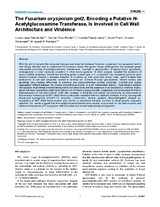The Fusarium oxysporum gnt2, Encoding a Putative NAcetylglucosamine Transferase, Is Involved in Cell Wall Architecture and Virulence
Autor
López Fernández, Loida
Ruiz Roldán, Carmen
Pareja Jaime, Y.
Prieto, A.
Khraiwesh, Husam M.
González Roncero, M. Isabel
Editor
Public Library of ScienceFecha
2013Materia
Plant fungal pathogensFungal structure
Fusarium oxysporum
Plant cell walls
Glycosylation
Fungal diseases
Saccharomyces cerevisiae
Tomatoes
METS:
Mostrar el registro METSPREMIS:
Mostrar el registro PREMISMetadatos
Mostrar el registro completo del ítemResumen
With the aim to decipher the molecular dialogue and cross talk between Fusarium oxysporum f.sp. lycopersci and its
host during infection and to understand the molecular bases that govern fungal pathogenicity, we analysed genes
presumably encoding N-acetylglucosaminyl transferases, involved in glycosylation of glycoproteins, glycolipids,
proteoglycans or small molecule acceptors in other microorganisms. In silico analysis revealed the existence of
seven putative N-glycosyl transferase encoding genes (named gnt) in F. oxysporum f.sp. lycopersici genome. gnt2
deletion mutants showed a dramatic reduction in virulence on both plant and animal hosts. Δgnt2 mutants had
αalterations in cell wall properties related to terminal αor β-linked N-acetyl glucosamine. Mutant conidia and
germlings also showed differences in structure and physicochemical surface properties. Conidial and hyphal
aggregation differed between the mutant and wild type strains, in a pH independent manner. Transmission electron
micrographs of germlings showed strong cell-to-cell adherence and the presence of an extracellular chemical matrix.
Δgnt2 cell walls presented a significant reduction in N-linked oligosaccharides, suggesting the involvement of Gnt2 in
N-glycosylation of cell wall proteins. Gnt2 was localized in Golgi-like sub-cellular compartments as determined by
fluorescence microscopy of GFP::Gnt2 fusion protein after treatment with the antibiotic brefeldin A or by staining with
fluorescent sphingolipid BODIPY-TR ceramide. Furthermore, density gradient ultracentrifugation allowed colocalization
of GFP::Gnt2 fusion protein and Vps10p in subcellular fractions enriched in Golgi specific enzymatic
activities. Our results suggest that N-acetylglucosaminyl transferases are key components for cell wall structure and
influence interactions of F. oxysporum with both plant and animal hosts during pathogenicity.

